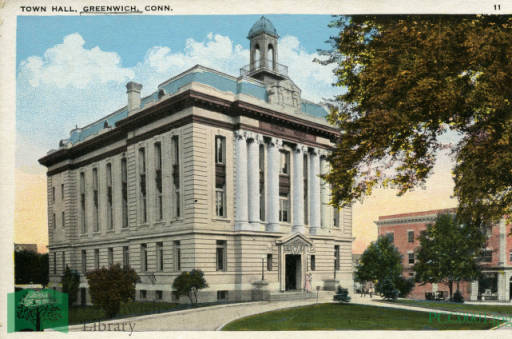Originally written by Carl White.
Greenwich Town Hall
At one time, the Greenwich Town Hall was located at the corner of Maple Street and the Boston Post Road – where the Soldiers’ Monument is now located across from the Second Congregational Church. It was built around 1760, and some thought it should have been more centrally located. It was paid for by a tax on livestock at “one penny on the pound.” Greenwich was still a farming community, so it had that “country feel.” Horseneck (central Greenwich) had yet to become a major business center. During the Revolutionary War, it was used as a guardhouse for the Greenwich Artillery Company. In 1779, it was burned during General Tryon’s Raid and was not rebuilt until 1836. This was because public (Town) meetings had been held in the Second Congregational Church, and the movement to separate church and state was gaining public support.
Greenwich Business Center
Old Greenwich (or Sound Beach) was considered the first business center. Then, the Upper Landing in Cos Cob became the center of trade. Boats loaded with local goods departed the docks near Palmer’s Hill and sailed to markets in New York, Long Island, and the Connecticut coast. Central Greenwich was not as important a business center as it is today. When Town Meetings started to be held in central Greenwich, the center shifted to Horseneck. The “Townhouse,” as it was called, began to increase in importance as a civic center. A ladies’ Benevolent Society used it for an annual fair, and occasionally an acting company would use the space to perform a play. That’s not to say there was no official business; judges and justices of the peace used the space for trials, and there was a lockup in the basement. Students from Greenwich Academy (next door) would hang out on its large stone steps. It was also used for voting. At the start of the Civil War, it became a center for departing and returning soldiers.
Town Hall Fire
On October 15, 1874, the Town Hall burned to the ground. It started under a wooden sill, where an old coat saturated with oil and covered with wood shavings was found on the west side of the building. The fire was obviously a case of arson. There were initially no suspects. It took seventeen years to solve this mystery. An anonymous letter was received by one of the Town’s Constables, which helped crack the case.

An itinerant tramp named Allan H. Armitage was the culprit. Armitage was from Ohio, the son of a noted clergyman. He came from a good family and received an excellent education. Unfortunately, he had little money and no ambition. Arriving in Greenwich in 1874, he lived on a farm and worked for money to pay for cider and tobacco. He was a gambler and attended all the cock fights in town.
One evening, after getting supper at a farmhouse near the train station, he walked up Milbank Avenue around 9:30 pm. He had to wait for several people to pass before walking across the street to the Town Hall. Even though a group of nurses was located in front of the church, they didn’t notice him because they were busy talking. Armitage walked across the street and stood behind Tweed’s fence. After ten minutes, the fire really flared up, and its light reflected off the church steeple. The boy carefully retreated so as not to be seen. He stayed in Brush Knapp’s barn that night. Shortly thereafter, he disappeared from Town.
Suspect Apprehended
No doubt the anonymous letter tipped the Constable off about where the boy was hiding. He found the boy in jail in one of the middle states, accused of horse stealing. He claimed he was innocent of the arson. Armitage died before his horse stealing trial. A diary was found among his personal effects. In it, he admitted to setting the fire and provided all the details above.
Fortunately, no one was hurt in the fire. Armitage claimed no one really cared that the building burned down. This is hard to believe since such devastation is very costly. There’s also some mystery regarding his untimely death. Maybe it was payback for being a horse thief. Chances are we may never know. This may forever remain a mystery.
SOURCES
Carley, R; Building Greenwich – Architecture and Design, 1640 to Present; Greenwich Historical Society, 2005.
Hubbard, F; Greenwich History: The Judge’s Corner; Round Hill Productions, Greenwich CT, 2000.
Mead, S: Ye Historie of Ye Town of Greenwich; Knickerbocker Press, NY; 1911.
ABOUT
Build your family tree, dive into the history of your historic home, and discover photos and articles of days gone past with the Library’s collection of 5,000 books, 800 Oral History transcripts, yearbooks, historical maps, vertical files, pamphlets, periodicals, and microfilm and microfiche. Plus, access resources like American Ancestors, AncestryLibrary, and more with a Library card. Learn more at greenwichlibrary.org/genealogy.
Get the latest about the Library’s History & Genealogy events and offerings sent to your email: greenwichlibrary.org/enews.
Questions? Contact:
Local History Librarian
(203) 622-7948
